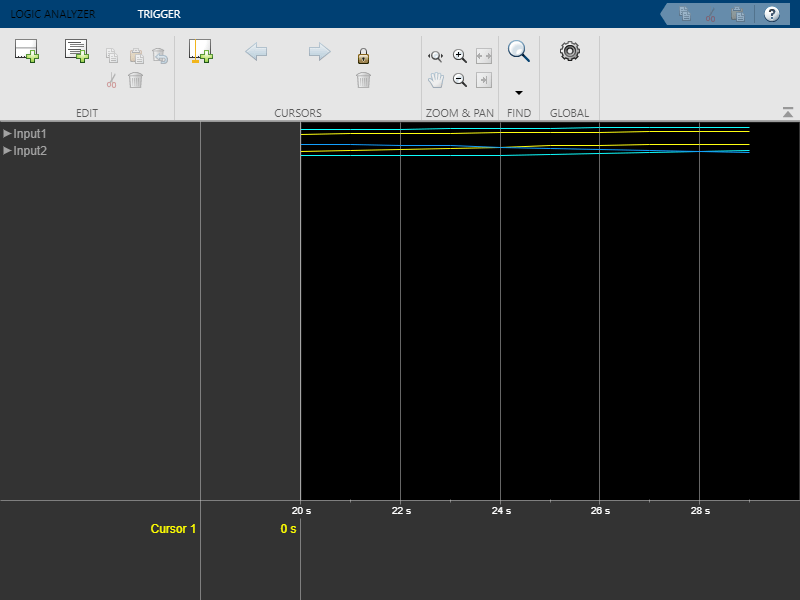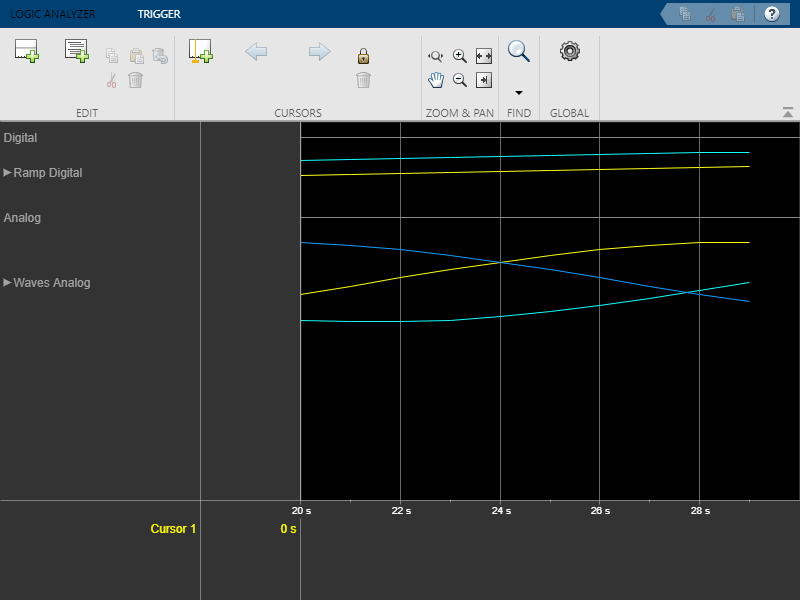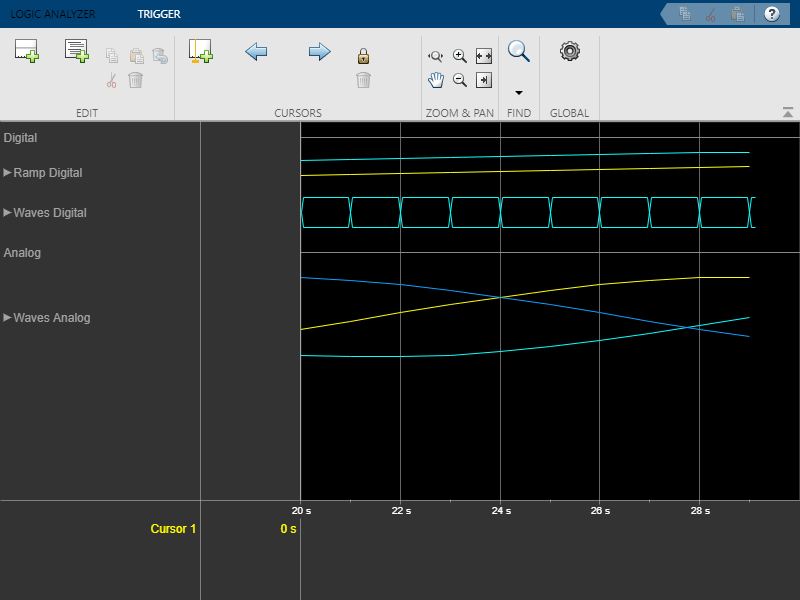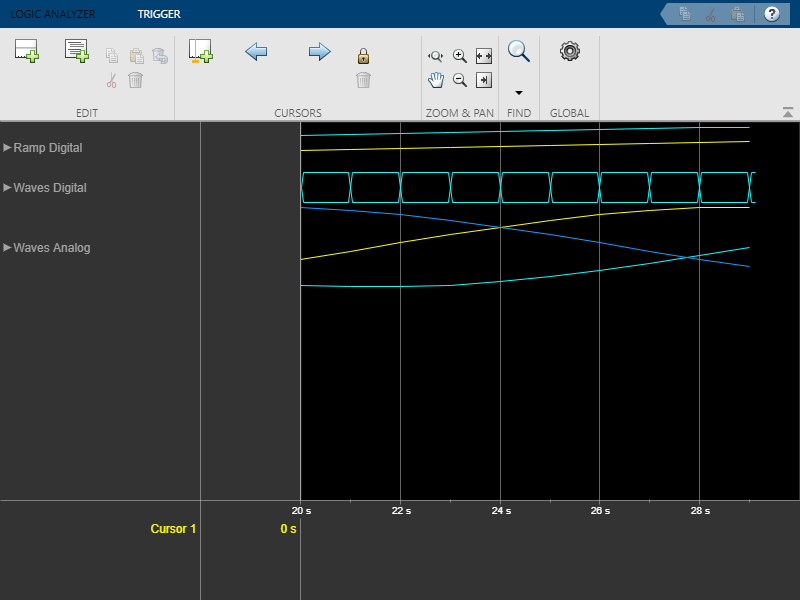modifyDisplayChannel
Modify properties of Logic Analyzer display channel
Description
Examples
Create a dsp.LogicAnalyzer object with four channels. Call modifyDisplayChannel to set the radix of each of the channels. Run the scope in a loop to display the waves.
scope = dsp.LogicAnalyzer('NumInputPorts',4,'DisplayChannelFormat','Digital'); scope.TimeSpan = 12; modifyDisplayChannel(scope,1,'Name','Index','Radix','Unsigned decimal'); modifyDisplayChannel(scope,2,'Name','Fi_hex','Radix','Hexadecimal'); modifyDisplayChannel(scope,3,'Name','Fi_bin','Radix','Binary'); modifyDisplayChannel(scope,4,'Name','Fi_actual','Radix','Signed decimal'); for ii = 1:20 fival = fi((ii-1)/16,0,4,4); scope(ii,fival,fival,fival); end

Use functions to construct and manipulate a dsp.LogicAnalyzer System object.
Display Waves on Logic Analyzer scope.
scope = dsp.LogicAnalyzer('NumInputPorts',2); stop = 30; for count = 1:stop sinValVec = sin(count/stop*2*pi); cosValVec = cos(count/stop*2*pi); cosValVecOffset = cos((count+10)/stop*2*pi); scope([count (count-(stop/2))],[sinValVec cosValVec cosValVecOffset]) end

Reorganize Display
hide(scope) digitalDividerTag = addDivider(scope,'Name','Digital','Height',20); analogDividerTag = addDivider(scope,'Name','Analog','Height',40); tags = getDisplayChannelTags(scope); modifyDisplayChannel(scope,tags{1},'InputChannel',1,... 'Name','Ramp Digital','Height',40); modifyDisplayChannel(scope,tags{2},'InputChannel',2,... 'Name','Waves Analog','Format','Analog','Height',80); moveDisplayChannel(scope,digitalDividerTag,'DisplayChannel',1) moveDisplayChannel(scope,tags{2},'DisplayChannel',length(tags)) show(scope)

Duplicate Wave and Check Information
hide(scope) addWave(scope,'InputChannel',2,'Name','Waves Digital','Format','Digital',... 'Height',30,'DisplayChannel',3); show(scope)

Remove Dividers
hide(scope) deleteDisplayChannel(scope,digitalDividerTag) deleteDisplayChannel(scope,analogDividerTag) show(scope)

Clear variables
clear analogDividerTag cosValVec cosValVecOffset count digitalDividerTag duplicateWave scope sinValVec stop tags
Input Arguments
The Logic Analyzer object for which you want to modify a display channel,
specified as a handle to the dsp.LogicAnalyzer object.
The tag identifying which display channel to modify.
Example: modifyDisplayChannel(scope,tag)
Example: modifyDisplayChannel(scope,'W4')
Data Types: char | string
The first section on Name-Value Pair Arguments shows the properties you can set if the display channel contains a wave. The second section on Name-Value Pair Arguments shows the properties you can set if the display channel contains a divider.
Name-Value Arguments
Specify optional pairs of arguments as
Name1=Value1,...,NameN=ValueN, where Name is
the argument name and Value is the corresponding value.
Name-value arguments must appear after other arguments, but the order of the
pairs does not matter.
Before R2021a, use commas to separate each name and value, and enclose
Name in quotes.
Example: 'InputChannel',2,'Color','Blue' specifies that a wave should be added to input channel 1 and
colored blue.
Color of the wave, specified as an [R G B] value or one of the following:
'Black''Blue''Cyan''Default''Green''Magenta''Red''White''Yellow'
When you choose 'Default', the value of the DisplayChannelColor
property in the Logic Analyzer is used.
Example: 'Color','Blue'
Example: 'Color',[0,0,1]
Data Types: char | string | double | single | uint8 | uint16 | uint32 | uint64 | int8 | int16 | int32 | int64
Specify as a scalar numeric value the display channel that shows this wave. By default, the wave is added to the end of the display.
Example: 'DisplayChannel',2
Data Types: double | single | uint8 | uint16 | uint32 | uint64 | int8 | int16 | int32 | int64
Specify as a scalar nonnegative integer the font size in points. When you choose 0, the value of the
DisplayChannelFontSize property in the Logic Analyzer is used.
Example: 'FontSize',8
Data Types: double
When you choose 'Default', the value of the DisplayChannelFormat
property in the Logic Analyzer is used.
Example: 'Format','Digital'
Data Types: char | string
Specify as a scalar integer the height of the wave in the display in units of
16 pixels. When you choose 0, the value of the
DisplayChannelHeight property in the Logic Analyzer is
used.
Example: 'Height',2
Data Types: double
This property specifies the input channel whose data is used for this wave. By default, it will connect the first input to this wave.
Example: 'InputChannel',2
Data Types: double | single | uint8 | uint16 | uint32 | uint64 | int8 | int16 | int32 | int64
Specify the name that you would like to set for the new wave.
Example: 'Name','MyWave'
Data Types: char | string
When the input signals are of class double, single, or logical, you should not set this property. When you
choose 'Default', the value of the DisplayChannelRadix property in the
Logic Analyzer is used.
Data Types: char | string
Name-Value Arguments
Specify optional pairs of arguments as
Name1=Value1,...,NameN=ValueN, where Name is
the argument name and Value is the corresponding value.
Name-value arguments must appear after other arguments, but the order of the
pairs does not matter.
Before R2021a, use commas to separate each name and value, and enclose
Name in quotes.
Example: 'DisplayChannel',2,'Name','MyDivider' specifies that a divider should be added to display
channel 2 and named “MyDivider”.
Specify as a scalar numeric value the display channel that shows this divider. By default, the divider is added to the end of the display.
Example: 'DisplayChannel',2
Data Types: double | single | uint8 | uint16 | uint32 | uint64 | int8 | int16 | int32 | int64
Specify, in pixels, the height of the divider as a scalar integer in the range 8-200. If you choose 0, the
value of the DisplayChannelHeight property in the Logic Analyzer is used.
Example: 'Height',2
Data Types: double
Specify the name that you would like to set for the new divider.
Example: 'Name','MyDivider'
Data Types: char | string
Version History
Introduced in R2013a
MATLAB Command
You clicked a link that corresponds to this MATLAB command:
Run the command by entering it in the MATLAB Command Window. Web browsers do not support MATLAB commands.
Sélectionner un site web
Choisissez un site web pour accéder au contenu traduit dans votre langue (lorsqu'il est disponible) et voir les événements et les offres locales. D’après votre position, nous vous recommandons de sélectionner la région suivante : .
Vous pouvez également sélectionner un site web dans la liste suivante :
Comment optimiser les performances du site
Pour optimiser les performances du site, sélectionnez la région Chine (en chinois ou en anglais). Les sites de MathWorks pour les autres pays ne sont pas optimisés pour les visites provenant de votre région.
Amériques
- América Latina (Español)
- Canada (English)
- United States (English)
Europe
- Belgium (English)
- Denmark (English)
- Deutschland (Deutsch)
- España (Español)
- Finland (English)
- France (Français)
- Ireland (English)
- Italia (Italiano)
- Luxembourg (English)
- Netherlands (English)
- Norway (English)
- Österreich (Deutsch)
- Portugal (English)
- Sweden (English)
- Switzerland
- United Kingdom (English)